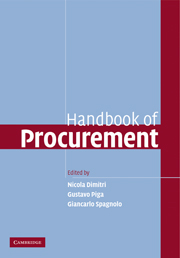Book contents
- Frontmatter
- Contents
- List of figures
- List of tables
- List of contributors
- Preface
- Part I Preliminary Issues
- Part II General Strategic Principles
- Part III Competitive Tendering Strategies
- Part IV Attracting and Screening Participants
- 10 Pricing and other business strategies for e-procurement platforms
- 11 Fostering participation
- 12 Scoring rules
- 13 Managing risky bids
- Part V Preventing Collusion and Corruption
- Part VI Dynamic Forces and Innovation
- Glossary
- Index
- References
11 - Fostering participation
Published online by Cambridge University Press: 04 November 2009
- Frontmatter
- Contents
- List of figures
- List of tables
- List of contributors
- Preface
- Part I Preliminary Issues
- Part II General Strategic Principles
- Part III Competitive Tendering Strategies
- Part IV Attracting and Screening Participants
- 10 Pricing and other business strategies for e-procurement platforms
- 11 Fostering participation
- 12 Scoring rules
- 13 Managing risky bids
- Part V Preventing Collusion and Corruption
- Part VI Dynamic Forces and Innovation
- Glossary
- Index
- References
Summary
Introduction
Participation in tendering processes is a crucial dimension of procurement. A commonly accepted view is that a large pool of suppliers has to be attracted in order to obtain economically advantageous conditions. The main intuitive reason is that, in most circumstances, a large number of participants induces tough competition which, in turn, translates into high savings and attractive standards of quality. Suppliers, however, differ in various respects. Market shares, access to the credit market, and information on the nature of the procurement contract are just a few dimensions of heterogeneity among them. Thus, if large participation may be per se a desirable feature of a procurement tendering process, the final outcome will eventually be affected by the individual characteristics of participants. If only a few large suppliers participate it is likely that they will attempt to reach a tacit agreement to soften price–quality competition. If, instead, the pool of potential suppliers includes a large number of big and small firms, then anti-competitive behaviour becomes more difficult to sustain.
The buyer then faces a double task: attracting a large number of participants and affecting the pool of suppliers in order to stimulate the participation of the most efficient ones in the market.
- Type
- Chapter
- Information
- Handbook of Procurement , pp. 267 - 292Publisher: Cambridge University PressPrint publication year: 2006
References
- 8
- Cited by

